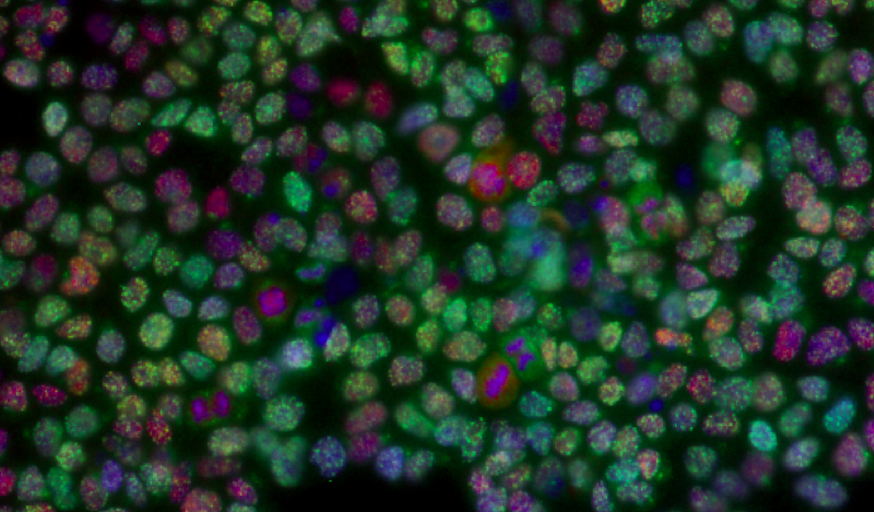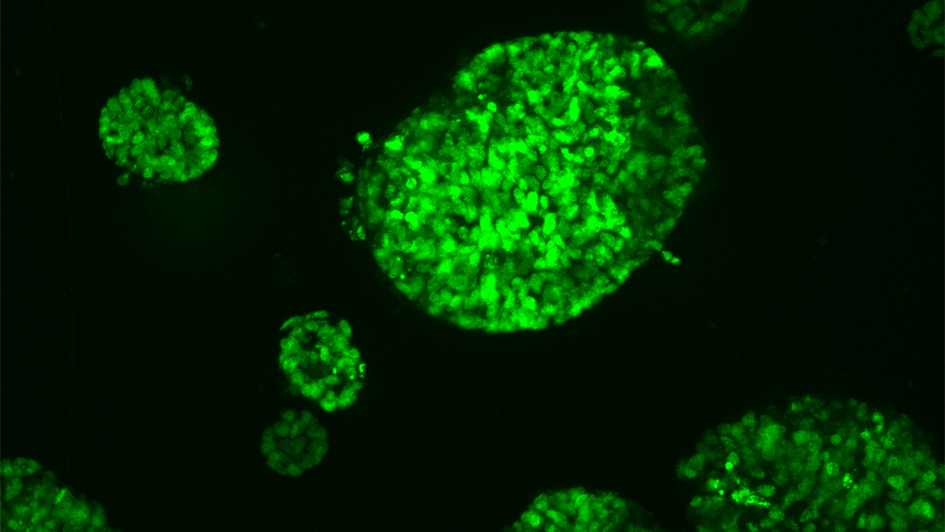DNA damage and cancer
We provided the first conclusive evidence that the basic cause of cancer is damage to DNA. The discovery changed scientific opinion dramatically and marked a turning point for cancer research.
Until that point, scientists had assumed carcinogens caused cancer by acting on proteins, rather than genes.

Nuclei of tumour cells stained with a blue dye and two markers of DNA damage resulting from irradiation. Credit: Dr Susanne Gatz from the ICR's Sarcoma Molecular Pathology Team.
Research conducted here at The Institute of Cancer Research in the 1950 and 60s provided the first conclusive evidence indicating that damage to DNA is the root cause of cancer.
Cancer cells replicate at an accelerated rate, often ignoring the normal controls on cell division and growth. Proteins within cells regulate growth and division, and were widely assumed to be the targets for cancer-causing chemicals. However, research conducted at the ICR by Professor Philip Lawley and Professor Peter Brookes showed that cancer is caused by damage not to proteins but to DNA.
Mustard gas
Their discovery was made through working on mustard gas – which was known to cause cancer. In 1960, Professors Lawley and Brookes published a paper which showed that mustard gas reacted with both pure DNA and with the DNA of mice when injected into tumours.
In 1964, Professors Lawley and Brookes published their second classic paper. This used radiolabelled poly-aromatic hydrocarbons (PAHs), which are among the chemicals that give cigarettes their cancer-causing properties. They found a direct correlation between a PAH’s ability to induce tumours when applied to mouse skin, and the degree to which it bound to DNA. There was no correlation with the degree to which the PAH bound to proteins. It was this finding that showed that cancer was caused by chemicals damaging DNA rather than proteins.
'A turning point'
This discovery marked a turning point for cancer research, and is the basis of all modern cancer research and treatment. It explains why some cancers can be inherited, enabling people with a particularly high risk of developing certain cancers to be identified. It has also changed the way that scientists search for new cancer drugs, allowing personalised treatments to be developed that target the specific genetic defects in an individual’s cancer.
References
Brookes and Lawley (1960) The reaction of mustard gas with nucleic acids in vitro and in vivo, Biochem. J., 77, 478–484
Brookes and Lawley (1964) Evidence for the Binding of Polynuclear Aromatic Hydrocarbons to the Nucleic Acids of Mouse Skin: Relation between Carcinogenic Power of Hydrocarbons and their Binding to Deoxyribonucleic Acid, Nature 202, 781 – 784 doi:10.1038/202781a0
Related news
Related blogs
Rider McDowell’s son Errol was diagnosed with medulloblastoma, a fast-growing malignant brain tumour, when he was 12. Despite six years of intensive treatment, Errol passed away in 2018. Before he died, Errol was committed to raising money to fund more research into childhood cancer – and today, his younger brothers, Mac and Piers, continue his legacy, hoping to raise £1m for cancer research in the UK.

